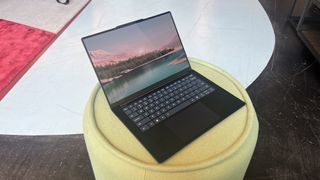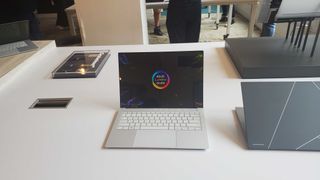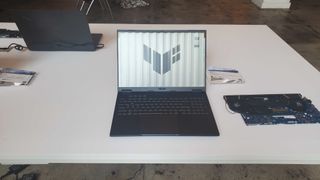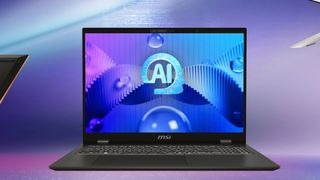Computex 2024 has offered up a whirlwind of new and exciting laptops of all different shapes and sizes, with new AI-powered chipsets running the show. It’s been one of the more eventful years with the unveiling of the new Ryzen AI 300 chipsets alongside demonstrating the power of the Qualcomm Snapdragon X silicon. We even got our first look at Intel Lunar Lake scheduled for release later this year.
With so many models announced, I’ve narrowed things down to a top-five list of the best laptops of Computex 2024. There’s a steady mixture of gaming-focused rigs and productivity powerhouses that you should have on your radar over the next few months. Time will tell just how these new rigs can rival the best laptops available.
We’ve extensively covered everything happening at Computex 2024 since the event began earlier this week. The full hub has all the big reveals, keynote details, hands-on coverage, and more for thorough further reading.
The best laptops of Computex 2024

The Lenovo Yoga 7x 14 looks to be an incredibly powerful productivity machine which takes advantage of the Qualcomm Snapdragon X APU. In our hands-on, we noted an excellent display combined with a thin and light design, including a great keyboard and touchpad at an affordable price point.
Unfortunately, we didn’t get to go too in-depth with the AI features or test the battery life much, but the first impressions were definitely positive. This rig is set to feature a 14.5-inch OLED 3K (2994 x 1840) display at 90Hz with a peak brightness of 1,000 nits. There’s also 32GB LPDDR5X RAM and a 1TB Gen 4.0 NVMe SSD. It weighs in at an impressively light 2.82 lbs / 1.28 kg, too. It should be a good upgrade over its predecessors.

The new Asus Zenbook S 16 appears to be the company’s answer to the MacBook Pro M3 with a similar pricing of $1,699.99 / £1,599.99 (around AU$2,550). Design-wise, the Taiwanese company has packed in a leading 16-inch 3K Lumina OLED display clocked at 120Hz which will feature the brand new Ryzen AI 9 SoC.
There are also RDNA 3 integrated graphics inside as well, which if recent leaked benchmarks can be believed, can rival some older discrete graphics solutions. Depending on your region, there’s a maximum of 32GB LPDDR5x RAM inside with 1TB Gen 4.0 NVMe, too. It weighs in at a sleek 3.31 lbs / 1.50kg as well.
The thermals have been completely reconsidered with the new Asus Zenbook S 16, as it now comes with a totally new ventilation system. Asus calls this “Airvent,” and it’s meant to improve airflow while pushing out unwanted dust and moisture. While this rig likely won’t get anywhere near as hot as top-end gaming laptops, any way to keep them cool is a win in our book.

Previous leaks from back in May were accurate when considering the newly revamped Asus TUF Gaming A16 and A14 machines. Both of these rigs are coming on July 22 in the US, the UK, and Australia so there’s not long to wait at all. They are priced respectively from $1,799.99 / £1,799.99 / AU$2,299 and $1,399.99 / £1,299 / (around AU$2,400) putting the two firmly in the upper mid-range.
Our hands-on at Computex reveals both of these rigs feature an excellent QHD+ display clocked at 165Hz with a peak brightness of 400 nits apiece. They will both support up to an RTX 4070 with 8GB GDDR6 VRAM, 32GB LPDDR5x, and up to a 2TB NVMe Gen 4.0 SSD. They’re also fairly lightweight at 4.84 lbs / 2.20kg and 3.22 lbs / 1.46 for the A16 and A14 variants as well.
We like the design which is sleeker and more premium-looking than the bulkier and primarily plastic chassis of previous versions. This includes an aluminium lid and bottom cover for enhanced durability. The glass trackpads here are especially nice and the stellar port selections don’t hurt either. For the price tag, these are among the best gaming laptops we’ve seen at the event.

Shaking things up, there’s the newly revealed and soon-to-be-released HP OmniBook X AI PC which is slated for a June 18 release date. It’s priced reasonably at $1,199.99 (around £1,020 / AU$1,960) given the hardware and display inside, too. There’s a 14-inch 2.2K (2240 x 1400) display with a peak brightness of 300 nits, and the Qualcomm Snapdragon X Elite at the heart of the experience.
We weren’t able to take the AI features for much of a test drive in our limited hands-on experience, however, we did get a feel for the machine overall. That includes its super sleek new chassis which weighs in at just 2.97 lbs / 1.3kg, and a solid array of ports for everyday productivity. The keyboard and touchpad are among the best we’ve used, too.
HP has made some bold but exciting claims about its first-generation AI PC. This includes a quoted 26-hour battery life when casually browsing, and up to 22 hours with media playback such as Netflix. In standby, it’s reported to last up to 20 days on a single charge, and can even beat out the pricier MacBook Air M3 in multi-threaded performance, too. This machine is one to keep an eye on for sure.

Lastly, while we didn’t get to go hands-on with the suite of AI-powered MSI laptops, the new lineup is definitely encouraging. This includes the teased Intel Core Ultra 200 (Lunar Lake) machines which claim up to three times the performance of Meteor Lake inside. This means 100 TOPS of AI performance with the CPU, GPU, and NPU in tandem.
Speaking to the Prestige series, there are going to be three sizes to choose from including 13, 14, and 16-inch variants. MSI claims the Prestige 13 AI+ Evo will weigh in at just 2.1 lbs / 990g with a 75W battery for “all-day uninterrupted battery life”. The Summit 13 AI+ Evo, aimed at business use, will also feature Lunar Lake silicon with its 13-inch 2-in-1 flip design.
Gamers and creatives also seem covered with the MSI Stealth A16 AI and MSI Creator A16 AI. These rigs are built with the new Ryuzen AI 300 series processors in mind with up to 12 cores and 24 threads for more powerful performance. RTX 40 series discrete graphics will be included, but it’s unknown if this will range up to RTX 4090 or not at this time.